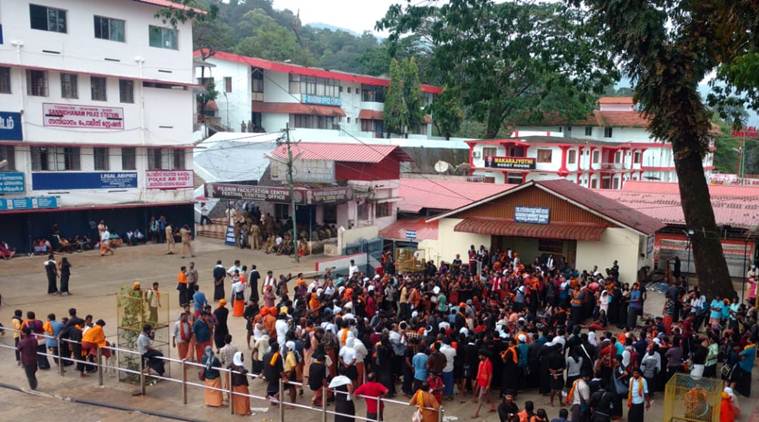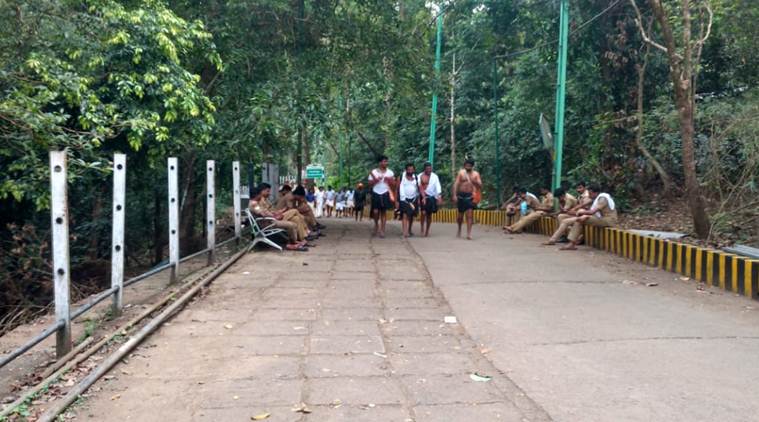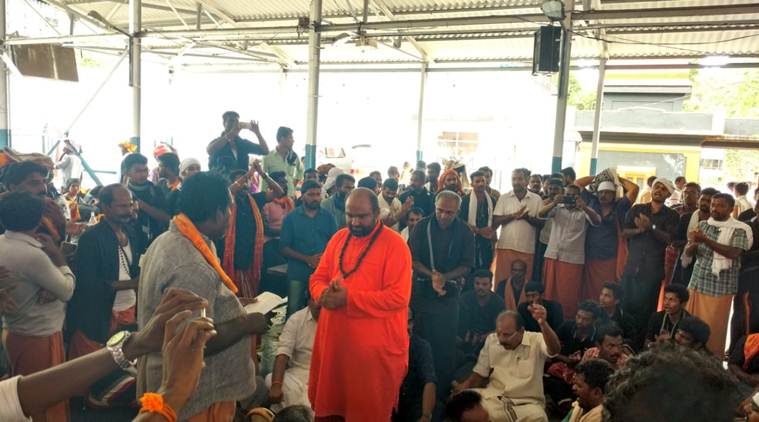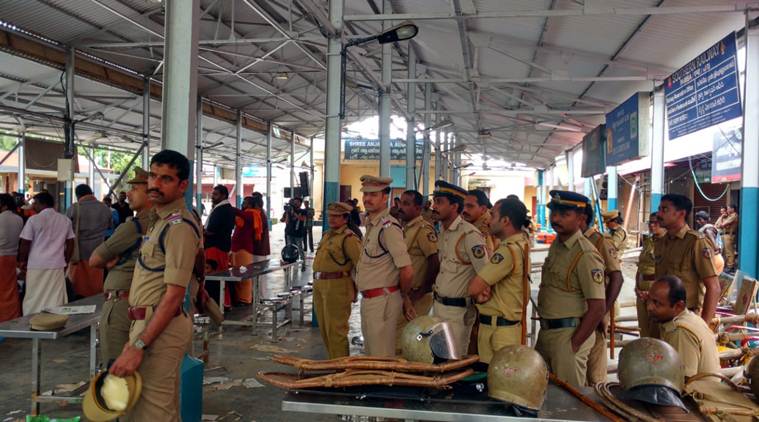Voices from a trek to Sabarimala: Misogyny, anger at the TDB and a rising right-wing TV channel
Despite the ruling LDF government’s commitment to implementing the SC verdict and the powerful police force at its disposal, the hill shrine, over the last one month, has resembled a war zone with activists of Hindu outfits camping there in their supposed bid to ‘protect traditions and customs'

So far, the Supreme Court judgment has remained merely on paper with no woman between the ages of 10 and 50 (the previous traditionally-barred age limit) successful in upending gender barriers to offer prayers at the temple. (Express Photo: Vishnu Varma)
It’s been exactly 41 days since India’s top court delivered a far-reaching judgment ending age-related constraints on the entry of women at the Sabarimala temple, a shrine that sits on top of a hill deep inside the forests of the Western Ghats in Kerala. During this period, the temple dedicated to Lord Ayyappa opened to pilgrims twice, for a total of eight days. But so far, the judgment has remained merely on paper with no woman between the ages of 10 and 50 (the previous traditionally-barred age limit) successful in upending gender barriers to offer prayers at the temple.
Despite the ruling LDF government’s commitment to implementing the Supreme Court verdict and the powerful police force at its disposal, the hill shrine, over the last one month, has resembled a war zone with activists of Hindu outfits camping there in their supposed bid to ‘protect traditions and customs’. For a state that proudly upheld its secular and liberal values, the row over women’s entry at the temple has turned deeply political, threatening to derail its rich history of social reform movements. It’s also, in many ways, becoming a heady cocktail with a dark communal aftertaste, capable of leaving a polarising effect on the state’s electoral masses.
This week, when the temple doors opened for a two-day ritual known as ‘Chithira Atta Vishesham’, commemorated in the memory of the last king of Travancore, I decided to trek up the 3.8 km stretch from the base camp of Pamba to the temple at Sabarimala. One of the best ways, I have realised, to gauge the sentiments of the pilgrims and the impression on the ground is to simply walk and climb the hill with them. The conversations they have among themselves and with other ‘swamis’ (term for Sabarimala pilgrims) along the way are perhaps the best barometer of the volatile situation at Sabarimala. This is what I learnt:
The strange glee of having ‘blocked’ women
Less than halfway to the shrine at the top, a group of male pilgrims from Kerala that I walked along with stop to converse with a ‘swami’ who’s climbing down the hill. ‘Swami saranam,’ they greet each other with a smile. “Are there any women at Pamba climbing up?” the lone pilgrim asks the group. One of them replies with a snigger, “yes, two women, but they were sent back. As long as we are here, no woman will climb”. His statement was not only incorrect as no woman of menstruating age had attempted to climb the hill on Tuesday, but it also underlines the deeply uncomfortable glee with which the ‘pilgrims’ gloat about having succeeded in their goals.
In fact, on the way to the shrine, such conversations and murmurs can be heard everywhere. Many of these conversations are glazed with deeply misogynist remarks, most of which can’t be reproduced here for obvious reasons. “They (women) must be beaten with sticks,” was among the more moderate statements I heard on the hill.
Disdain for the Devaswom Board
If there’s a player in this whole Sabarimala saga caught between the devil and the sea, it’s the Travancore Devaswom Board (TDB) that manages the temple. An autonomous institution, it is, however, deeply political and changes its tune with the change in governments. When the UDF was in power, it submitted an affidavit supporting the age-related restrictions on women. However, with LDF coming to power, the TDB’s management underwent a change and the state government backed entry of women of all ages. Today, the TDB is stuck in an extremely difficult position. On one hand, it has to follow the directions of the LDF government, on the other, it cannot be seen as disrespectful of temple traditions and rituals.
At Sabarimala and its base camps, contempt for the TDB and the manner in which it has ‘failed to uphold Hindu beliefs’ is quite evident. Catalysed by outfits affiliated to the Sangh Parivar, there’s a growing sense among the pilgrims that the TDB, the management of which is currently led by Communists, is heavily influenced by the agenda of the Left. “Disband the entire Devaswom Board. They are good for nothing,” one pilgrim was heard telling his friend.
‘Janam TV is true media’
One of the fascinating developments during the controversy has been the rise in popularity and ratings of Janam TV, a television news channel that panders to the right. The media landscape in Kerala over the years has largely been dominated by channels and newspapers that follow a left and centre-left stream of thought. The protests over Sabarimala has propelled for the first time a news channel that does in no way hide its affinity for the BJP-Sangh interests. Its open support of the age-restrictions on women has made it a darling among the right-wing masses. In recent weeks, its ratings have boomed and a large section of the pilgrims that stream into Sabarimala were heard vouching for its reporting.
“Everyone must abandon Mathrubhumi and Manorama (two leading news outlets of Kerala). Janam TV is the only channel showing the truth. It is the only channel that stands with devotees. They are the only ones reporting the developments correctly from Sabarimala,” one man tells the other on the trek up the hill. “Manorama is still calling us ‘samarakkar’ (protesters). We are not ‘bhaktar’ (devotees) for them,” he complained.
At several places on the way, I could see groups of young people huddled around, all glued to their cell-phones watching live stream of the news on Janam TV. The moment news breaks on TV of a woman between the age of 10-50 climbing the hill, these youngsters, in their 20s and 30s affiliated to organisations of the RSS, gear up to the block them. The tight coordination among these groups aided by a channel with vested interests has triumphed all the eight days the temple remained open.
‘70-80 per cent police are with us, they know we are in charge’
To avert the violence and lathi-charge that took place at the Sabarimala base camps in October-end, the police had imposed Section 144 to curb down on protests. The TDB ordered that all pilgrims must climb down the hill within two hours of darshan. But all those rules seemed to had little effect on the ‘pilgrim-protesters.’
Large groups of young protesters, ostensibly allied to the Sangh, remained posted at ‘Nadapanthal’, an important halting point on the climb up the hill. As women devotees passed by, they kept a close eye on them to make sure they fit into the below-10, above-50 age brackets. Nobody seemed to escape their scrutiny.
One of the protesters was heard telling another, “Everyone knows that we are in charge here. Even the police knows. I would say, 70-80 per cent of the police force indirectly support us.”
One of the police’s limitations this time has been its difficulty in separating actual pilgrims from the protesters, who were all dressed alike. According to local media reports, the police’s preliminary findings show that less than 5 per cent of the 7200 people who flowed into Sabarimala this week were ‘actual devotees’. The rest, they estimate, were marshalled to block women.
For all the latest Opinion News, download Indian Express App
More From Vishnu Varma
- Sabarimala shrine and base camps remain largely peaceful on final day of 2-day ritualThe temple doors would close at 10 pm Tuesday bringing to an end the two-day rituals of the 'Chithira atta vishesham' held to celebrate the…
- Kerala woman reaches Sabarimala base camp, returns after police explain ‘risks’Anju arrived at Pamba with her husband and two children, hoping to visit the shrine, but later decided to return, a police officer at Pamba…
- Kerala’s fastest, part-AC inland ferry to set sail on Ernakulam-Vaikkom routeThe ferry will be a much-needed fillip for office commuters from Vaikkom in Kottayam district who work in Kochi...

 One of the police’s limitations this time has been its difficulty in separating actual pilgrims from the protesters, who were all dressed alike. (Express Photo: Vishnu Varma)
One of the police’s limitations this time has been its difficulty in separating actual pilgrims from the protesters, who were all dressed alike. (Express Photo: Vishnu Varma) For a state that proudly upheld its secular and liberal values, the row over women’s entry at the temple has turned deeply political, threatening to derail its rich history of social reform movements. (Express Photo: Vishnu Varma)
For a state that proudly upheld its secular and liberal values, the row over women’s entry at the temple has turned deeply political, threatening to derail its rich history of social reform movements. (Express Photo: Vishnu Varma) To avert the violence and lathi-charge that took place at the Sabarimala base camps in October-end, the police had imposed Section 144 to curb down on protests. (Express Photo: Vishnu Varma)
To avert the violence and lathi-charge that took place at the Sabarimala base camps in October-end, the police had imposed Section 144 to curb down on protests. (Express Photo: Vishnu Varma)





































No hay comentarios:
Publicar un comentario